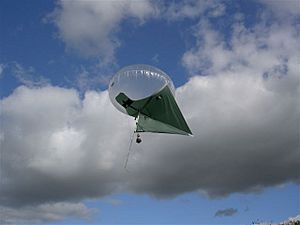Allsopp Helikite facts for kids
The Allsopp Helikite is a special type of aircraft that combines a helium balloon and a kite. It was invented by Sandy Allsopp in the UK in 1993. This unique design, sometimes called a kytoon, uses both wind (like a kite) and helium (like a balloon) to stay up in the air. It's a tethered aircraft, meaning it's always connected to the ground by a rope or cable.
Contents
How Helikites Are Designed
Helikites are built to be very reliable. They can stay in the air for a long time. Many tests around the world show they are efficient and cost-effective.
A Helikite has a balloon part filled with helium. It also has a strong carbon-fibre spine, which is like a backbone. The balloon is usually round and flat, like a squashed ball. This shape helps it fly well. It also has solid bars where you can attach equipment.
In most windy conditions, the lift from the wind is actually stronger than the lift from the helium gas.
Helikites are made to fly in all kinds of weather. They can also reach very high altitudes, up to 7,000 feet (about 2,100 meters). Their round, sturdy shape helps them handle strong winds. Both the wind lift and the helium lift happen at the front of the Helikite. The heavier parts, like the spine and keel, are at the back.
Why Helikites Are Better
Helikites have several advantages over older types of balloons.
- Smaller Size: Traditional balloons need a lot of helium to fight strong winds. This makes them very large and expensive. Helikites use wind for lift, so they can be much smaller.
- Higher Flying: Helikites can fly much higher than traditional balloons of the same size.
- Less Helium Needed: Because they are smaller and have fewer seams, Helikites leak less helium. This means they use less gas over time.
- Simpler Design: Helikites don't need special internal air bags called "ballonets." This makes them simpler to build. They also don't need constant electricity to stay airborne.
- Very Stable: Helikites are very steady in the air. This makes them great for holding cameras or scientific tools.
- Easy to Handle: Small Helikites can fly in all weather. They are easy to manage and don't need big, expensive machines to launch them. Some can even fit in a car when inflated!
- Versatile: Helikites can be small or very large. Larger ones can lift heavy equipment to high places.
Helikites are popular with scientists, the military, photographers, and emergency services. Telecom companies use them to lift 4G and 5G mobile phone towers. This helps bring phone service to areas without coverage.
Helikite Sizes and Lift
Helikites come in many sizes:
- The smallest is about 1 meter (3.3 feet) long. It holds 0.13 cubic meters of gas. It can lift about 30 grams (a little over an ounce).
- The largest can be 14 meters (46 feet) long. It holds 250 cubic meters of gas. It can lift up to 117 kilograms (about 258 pounds).
Different sizes can reach different heights:
- Small Helikites can fly up to 1,000 feet (300 meters).
- Medium Helikites can fly up to 3,000 feet (900 meters).
- Large Helikites can fly up to 7,000 feet (2,100 meters).
Official Classification
A Helikite is a new kind of tethered aircraft. It has its own official classification. It is different from other types of balloons.
- In the United States, customs officials call a Helikite "other non-powered aircraft."
- In the United Kingdom, the Civil Aviation Authority has a special classification just for "Helikites." This shows they are different from regular "kites" or "balloons."
Customs authorities often classify Helikites as a type of kite. This is because they get a lot of lift from the wind.
How Helikites Are Used
Helikites are used for many different jobs:
- Taking Pictures: They are great for aerial photography.
- Lifting Equipment: They can lift antennas, radio equipment, and surveillance gear.
- Advertising: Sometimes they carry advertisements high in the sky.
- Agriculture: Farmers use them to help control birds.
- Marking Positions: They can mark specific locations.
- Weather Research: Scientists use them to study the weather.
- Military Use: The military uses them as markers in jungles. They also lift radio relays and surveillance cameras.
Emergency and Special Uses
- Mobile Phone Coverage: British Telecom uses large Helikites (45 cubic meters) to lift 4G mobile phone towers. These are used for emergencies, big events, or areas with no phone signal. They can be launched quickly from special trailers.
- Oil Spill Response: Helikites are used by groups in Norway and the UK to help with oil spills at sea. They are the only compact aircraft that can work reliably in ocean conditions. Small Helikites are part of the emergency oil spill system in Scandinavia and the UK. They are especially useful for operations in the Arctic Ocean.
- Stable Platforms: Because Helikites are so stable, they can carry cameras that don't need special stabilizing equipment.
Military Surveillance
The British Army uses Helikites for surveillance. Their Helikites are 34 cubic meters in size. They lift lightweight cameras that can see in regular light and also with infrared. The US military uses even larger Helikites, 75 cubic meters in size. These carry bigger camera systems and targeting equipment. These Helikites work better than traditional balloons twice their size. They can lift surveillance equipment high enough to be safe from small arms fire.
Smallest and Largest Helikites
- The smallest Helikite ever made was tiny, just 0.028 cubic meters (1 cubic foot). It still flew well!
- The largest Helikite made so far is 250 cubic meters (8,750 cubic feet). It can lift 117 kilograms (258 pounds). The Max Planck Institute used this large Helikite. They flew it up to 7,000 feet (2,100 meters) to study cloud droplets. They launched it from research ships sailing across the Atlantic Ocean.


